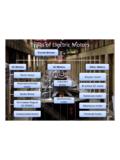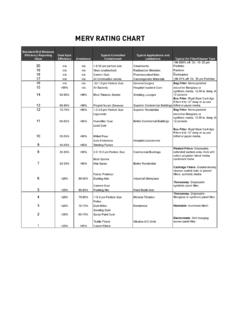Transcription of 5.0 SIDELOBE CANCELLATION - Engineering - Departments
1 SIDELOBE CANCELLATION . INTRODUCTION. SIDELOBE CANCELLATION (SLC) can be considered an extension of STAP. It is a spatial adaptive processing technique that is aimed at removing interference. In STAP, or more accurately SAP, the processor places nulls in the antenna pattern at the angular locations of the interference sources. In SLC, the processor attempts to subtract the interference from the antenna output. In fact, SLC is also likened to adaptive CANCELLATION techniques used in communication systems for removing interference and multipath signals SLC is designed to operate against active electronic attack (EA) devices (jammers) and not against clutter or passive interference such as chaff.
2 It is usually assumed that the EA signal is noise-like with a bandwidth that exceeds the intermediate frequency (IF) bandwidth of the radar receiver. It is also assumed that the EA signal is entering the radar antenna through one of its sidelobes. The fact that SLC cancels interference entering the radar through the antenna sidelobes is believed to be the origin of the term SIDELOBE CANCELLATION . BACKGROUND. We will derive the configuration of a SIDELOBE canceller (abbreviated SLC). by first examining the interference CANCELLATION problem.
3 To this end, Figure 1. contains a block diagram of an interference canceller. In this figure, the top antenna represents the main radar antenna and the bottom antenna is an auxiliary antenna used to gather information on the interference signal. The block with w t is the gain, or weight, (scalar in this case) analogous to the weight in STAP and the arrow through the box denotes that the weight is adjusted based on the error voltage, ve t . The error voltage is formed by subtracting a weighted version of the auxiliary channel signal, va t , from the main channel signal, vm t.
4 That is ve t vm t w t va t . (1). 1. Figure 1 Interference Canceller Configuration The resulting error signal is sent to the rest of the radar receiver and signal processor. (The interference canceller is implemented early in the receiver.). If the interference canceller is working correctly ve t will contain only the target, or desired, signal. Indeed, suppose we assume that the signal from the main antenna consists of a desired signal, vs t , and an interference signal, vI t . That is vm t K1vs t K 2vI t.
5 (2). Further, assume the auxiliary channel signal consists of only interference1. That is va t K3vI t . (3). Now, suppose we are able to choose the weight, w t , such that it is w t K 2 K3 . (4). If we can choose this w t we would get K2. ve t vm t w t va t K1vs t K 2vI t K 3vI t K1vs t . (5). K3. Thus, the error signal is, in fact, the desired signal. What we need now is a criterion for computing w t so that it behaves as indicated. 1 This may not be a good assumption in some cases but may be valid in others.
6 This will be discussed later 2. A METHOD FOR FINDING w t . Before we propose a criterion we need to recognize that vI t is a random process. Because of this vm t and va t are also random processes. This means that, for a particular t t1 , vI t1 , vm t1 va t1 and ve t1 are random variables. The implication of this is that we must use statistical methods to characterize the random variables and develop the criterion. With the above restrictions the criterion we will use is to choose w t1 so as to minimize the mean-squared value of ve t1.
7 Mathematically wopt t1 min E ve t1 . w t1 . 2. min E v t w t v t . w t1 . m 1 1 a 1. 2. (6). We use magnitudes because we recognize that vm t1 and va t1 must, in general, be represented by complex variables so as to capture their amplitude and phase. We use expectations because vI t1 is a random variable, which causes vm t1 and va t1 to be random variables2. We use the square because it is fairly easy to work with. The criterion given in Equation (6) is termed a least mean-square (LMS) criterion.
8 From our experience with quadratic, or squared error, minimization (recall least-squared curve fitting), we know that we can select wopt t1 as the w t1 at which the partial derivative of the mean-squared error with respect to w t1 is zero. That is . E vm t1 w t1 va t1 . 2. 0 (7). w t1 . w t1 wopt t1 . If we perform the indicated operation we get . 2 E vm t1 w t1 va t1 va t1 w t1 wopt t1 . 0 (8). which leads to the solution E vm t1 va t1 . wopt t1 . (9).. E va t1 . 2.. Although this result is interesting we want to see if it leads to an error signal that is reasonable.
9 That is, is ve t vs t , the desired signal. We will 2 We assume vs t1 is a deterministic (complex) variable. 3. assume that vI t is a zero-mean, wide-sense stationary (WSS), random process with a variance of . PI E vI t . 2.. (10). We let vm t and va t be as defined in Equations (2) and (3). With this we can write wopt t1 . E vm t1 va t1 .. E K1vs t1 K 2 vI t1 K 3vI t1 .. E va t1 . 2.. E K 3vI t1 . 2. , (11).. K2 K P K2. 3 I.. K3 K P K33 I. which is the result we said we needed to obtain ve t vs t (See Equation (4)).
10 Thus, we conclude that if we use the LMS methodology to determine the weight (gain), w t , the error signal out of the interference canceller will indeed contain vs t and not vI t at least in theory. PRACTICAL IMPLEMENTATION CONSIDERATIONS. Direct implementation of the LMS canceller as discussed thus far requires a priori knowledge of PI E vI t 2.. In general, this is not a practical assumption in that it requires knowledge of the interference source, which is not generally available. Because of this E va t 2.














